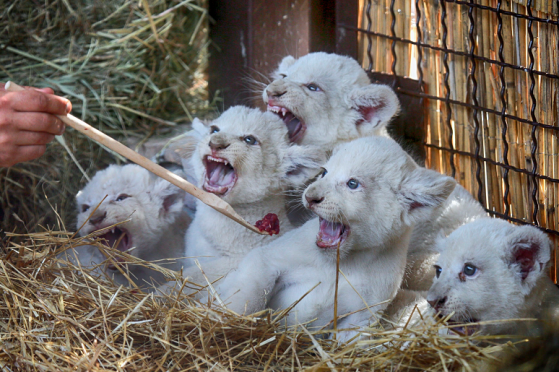These five adorable white cubs are among the rarest lions that exist in the world.
The cubs, who were born only two weeks ago in Ukraine, share a recessive gene, which is similar to the strain that also produces white tigers.
The animals are being raised at the XII months zoo in Damydiv, with their five-year-old father, Ludwig, who also possesses the recessive gene.
However, the rare litter is not the first creatures who have been born in Ukraine during the last few years.
In 2012, a unique instance of white cubs occurred at the Yalta Zoo after five of the tiny felines were born to a tawny-coloured lioness.
White lions are native to the Greater Timbavati region of South Africa, an area characterised by pale sandy riverbeds and grasses which have been scorched pale by the sun.
They are regarded as sacred animals by the indigenous people, but after Europeans ‘discovered’ them in the 1970s, many were taken from the wild into captive breeding and hunting operations, according to the Global White Lion Protection Trust.
Most of these animals live in captivity as the rare colour mutation is widely believed to make it difficult for white lions to survive in the wild.
However, since 2003, the GWLPT has been working to reintroduce white lions to their natural endemic range.
So far, their efforts have shown that the hunting success of a white lion pride was comparable to or even higher than the normal tawny wild prides of the Timbavati.
Despite their rarity, white lions are not yet classified as endangered because biologists still regard them as ultimately the same as their tawny equivalents.
This had long been because the genetic marker that makes white lions unique had not been identified by scientists, but in 2013 the gene was discovered.
However, the species have not been officially named as endangered.
The WLPT estimates that there are no more than 300 white lions in existence.
